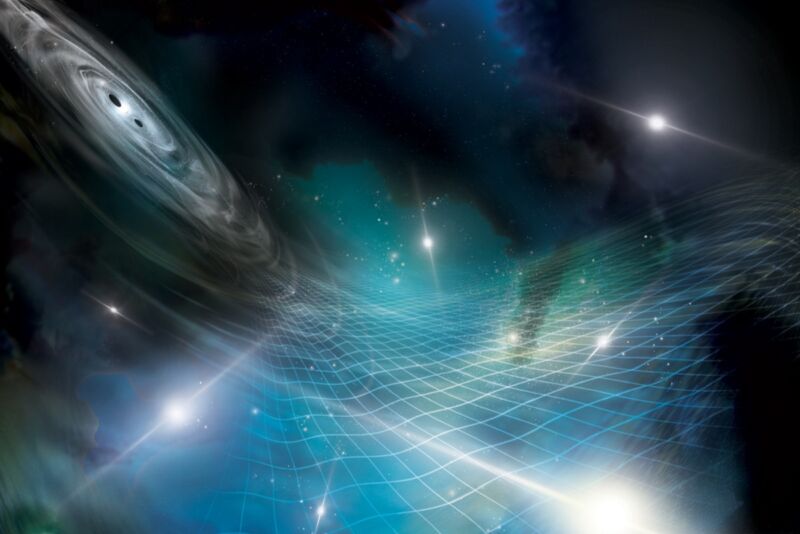
Enlarge / In this artist’s interpretation, a pair of supermassive black holes (top left) emits gravitational waves that ripple through the fabric of space-time. Those gravitational waves compress and stretch the paths of radio waves emitted by pulsars (white). (credit: Aurore Simonnet for the NANOGrav Collaboration)
Gravitational waves are ripples in the fabric of spacetime predicted by Albert Einstein's general theory of relativity, first detected in 2015. But an expected corresponding low-frequency gravitational wave background—a kind of "hum" comprised of a chorus of gravitational waves, most likely emanating from binary pairs of supermassive black holes—has proven more elusive. Now the North American Nanohertz Observatory for Gravitational Waves (NANOGrav) has announced the first evidence of this gravitational wave background. The results and related analyses are described in several new papers published in the The Astrophysical Journal Letters.
The collaboration stopped short of claiming outright detection, opting to describe their results instead as strong evidence of the expected gravitational wave background. That said, "In our statistical analyses, there's a less than 1-in-1,000 chance of nature giving our results without gravitational waves being present," NANOGrav chair Stephen Taylor of Vanderbilt University said during a press briefing.
As previously reported, LIGO detects gravitational waves via laser interferometry, using high-powered lasers to measure tiny changes in the distance between two objects positioned kilometers apart. LIGO has detectors in Hanford, Washington, and in Livingston, Louisiana. (A third detector in Italy, Advanced VIRGO, came online in 2016.) On September 14, 2015, at 5:51 am ET, both detectors picked up signals within milliseconds of each other for the very first time—direct evidence for two black holes spiraling inward toward each other and merging in a massive collision event that sent powerful shockwaves across spacetime. That first direct detection was announced on February 11, 2016, spawned headlines worldwide, snagged the 2017 Nobel Prize in Physics, and officially launched a new era of so-called "multi-messenger" astronomy.
Read 17 remaining paragraphs | Comments
